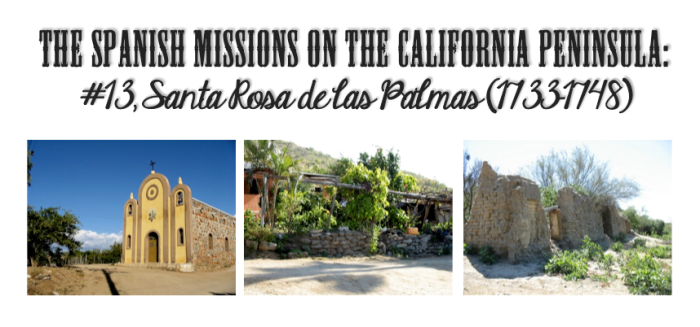
By David Kier
Co-author of ‘The Old Missions of Baja & Alta California, 1697-1834’
In 1724, Padre Jaime Bravo of the mission at La Paz heard of a ranchería (settlement) of Uchití natives (a Guaycura Indian group) some 50 miles to the south and two miles from the Pacific Ocean. Padre Bravo found the location excellent to become a farm and potential visita of his mission, Pilar de la Paz. Neophytes from Jesuit missions in Sinaloa were sent over to clear land for growing. Bravo named his visita ‘Todos Santos’ (no native name was recorded). By 1731, Todos Santos had become an important producer of food. When its own natives were nearly gone from epidemics or fighting with other Indian groups, some families of Pericú Indians living further south were brought in. In 1732, the Jesuits decided to establish a separate mission at Todos Santos just as soon as funds and a priest were available.
An endowment came from the Doña Rosa de la Peña (sister-in-law of the Marqués de Villapuente) to establish a new mission, which was to be named Santa Rosa, in her honor. Padre Sigismundo Taraval was the founding Jesuit, opening the mission in August of 1733. The visita name ‘Todos Santos’ was the typical name used to describe the place, even after it became the Mission of Santa Rosa de las Palmas.
Some confusion on the location of the new mission appears on old maps. That was due to letters describing the mission being on the Bay of Las Palmas, on the opposite coast of the peninsula. A visita named ‘Santa Rosa’ was just north of San José del Cabo, and contributed to the confusion.
Mission Santa Rosa was open barely a year when the Pericú Revolt broke out in October, 1734. Padre Taraval was practically dragged away by the soldiers attending him when word came that his Jesuit brothers in Santiago and San José del Cabo were murdered. Taraval had good Indian relationships and thought he could pacify the rebels. The four southernmost missions of Santiago, San José del Cabo, Santa Rosa, and Pilar de la Paz were destroyed. Taraval would later learn that the rebels killed 49 women and children at his mission.
Jesuits began to return to the southern missions after more than two years of fighting between Spanish soldiers and Indian rebels. The Presidio of the South had been established at San José del Cabo in 1737 in order to station more troops in the region. It was reduced to an Escuadra (sub-presidio) in 1741. By 1748, it was decided that the missions of the south could be consolidated from four to two by closing the missions at La Paz Bay and San José del Cabo. The Escuadra del Sur was also moved to Todos Santos.
In 1748, the mission of Santa Rosa de las Palmas was eliminated and replaced by the older mission that had been at La Paz Bay. Obviously this was a financial tactic, and while the mission name was changed from Santa Rosa to Nuestra Señora del Pilar de la Paz, it was still nearly always called Todos Santos.
When the Franciscans replaced the Jesuits in 1768, the population of neophytes was reported to be about 90. An adobe church measuring 67 feet by 25 feet was built in 1786 by the Dominicans, who had replaced the Franciscans in 1773. The native population had doubled to 181 in 1800, in one report. The mission remained at the same location until 1825 when it was moved a mile south, where the church is today in the town plaza. One visita of the mission was called San Jacinto and is about 15 miles to the southeast.
The original Santa Rosa mission site has become a car repair business (using some of the mission walls), and a church built in 1970. The 1825 mission site is the downtown church where newer construction was added to older walls and foundation. Mission functions ceased about 1840, but church services continued on for the newer population arriving from the mainland of Mexico. See also the chapter on La Paz, Mission #7.

- Visita de San Jacinto ruins. Photo by Jack Swords in 2003.
- David Kier is co-author of ‘The Old Missions of Baja & Alta California, 1697-1834’. The book is available for purchase HERE or at the DBTC offices (call 800-727-2252).


